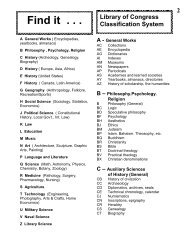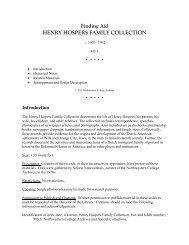Fall 2007 - Northwestern College
Fall 2007 - Northwestern College
Fall 2007 - Northwestern College
You also want an ePaper? Increase the reach of your titles
YUMPU automatically turns print PDFs into web optimized ePapers that Google loves.
<strong>Northwestern</strong> Classic<br />
Ofcourse<br />
Hollywood and the Meaning of Life<br />
Class<br />
Philosophy Through Film and Fiction<br />
Instructor<br />
Dr. Don Wacome, professor of philosophy<br />
If a film plays in a theatre and no one is there to hear it,<br />
does it make a sound?<br />
Students in Dr. Don Wacome’s course, Philosophy<br />
Through Film and Fiction, might want some popcorn while<br />
they mull that one over.<br />
A new take on a typical introduction to philosophy<br />
course, PHI 216 is offered annually. Students wait in line to<br />
get in, Wacome says, because they’d rather watch films than<br />
read a book. In PHI 216, though, they do both, watching 10<br />
films throughout the semester and reading nearly as much as<br />
they would for a typical introduction to philosophy course.<br />
Students spend three 90-minute class periods both<br />
watching the entire movie and then, when the lights come up,<br />
discussing the philosophical questions the film raises.<br />
After watching The Truman Show, for example, in which<br />
insurance salesman Truman Burbank, played by Jim Carrey,<br />
discovers he has been the unsuspecting star of an elaborate<br />
reality TV show since birth, students questioned whether it’s<br />
possible to know an objective reality. Or are we all limited to a<br />
perceived reality at best?<br />
Truman discovers he lives in a big dome and his whole<br />
life has been orchestrated by his show’s creator, Christof. What<br />
if the world is just a really big dome? And how does Truman’s<br />
and Christof’s relationship differ from ours with God?<br />
Wacome chose movies covered by the course’s text, most<br />
of which can be described as art house films rather than<br />
blockbusters.<br />
Several of the course movies are rated R. “It’s nearly<br />
impossible to find the kind of challenging movies you want<br />
for a course like this that don’t have something students might<br />
find objectionable,” says Wacome. So they talk about it. He<br />
takes pains to prepare students for movies’ content, and then<br />
he discusses with them questions like “What is a Reformed<br />
perspective on appropriate and inappropriate movies?”<br />
As engaging a lecturer as he is, Wacome concedes that<br />
Brad Pitt and Reese Witherspoon—or at least their characters—might<br />
be even more engaging for 18- to 22-year-olds,<br />
for whom movies are pervasive.<br />
“Film is one of the main art forms of our time,” says<br />
Wacome. “In addition to helping students understand philosophy,<br />
I also want to help them become more perceptive, critical<br />
and imaginative watchers of movies.”<br />
Text<br />
Movies and the Meaning of Life: Philosophers Take on<br />
Hollywood (Open-Court, 2005)<br />
Films<br />
Being John Malkovich, starring John Cusack and Cameron<br />
Diaz (1999)<br />
Boys Don’t Cry, starring Hilary Swank (1999)<br />
Chasing Amy, starring Ben Affleck (1997)<br />
Contact, starring Jodie Foster and Matthew McConaughey<br />
(1997)<br />
Crimes and Misdemeanors, starring Woody Allen (1989)<br />
Fight Club, starring Brad Pitt (1999)<br />
Groundhog Day, starring Bill Murray and Andie<br />
MacDowell (1993)<br />
Life is Beautiful, starring Roberto Benigni (1997)<br />
Memento, starring Guy Pearce (2000)<br />
Minority Report, starring Tom Cruise (2002)<br />
Pleasantville, starring Tobey Maguire and Reese<br />
Witherspoon (1998)<br />
Shadowlands, starring Anthony Hopkins and Debra<br />
Winger (1993)<br />
The Shawshank Redemption, starring Tim Robbins and<br />
Morgan Freeman (1994)<br />
The Truman Show, starring Jim Carrey (1998)<br />
7 ▲ <strong>Fall</strong> <strong>2007</strong>

















